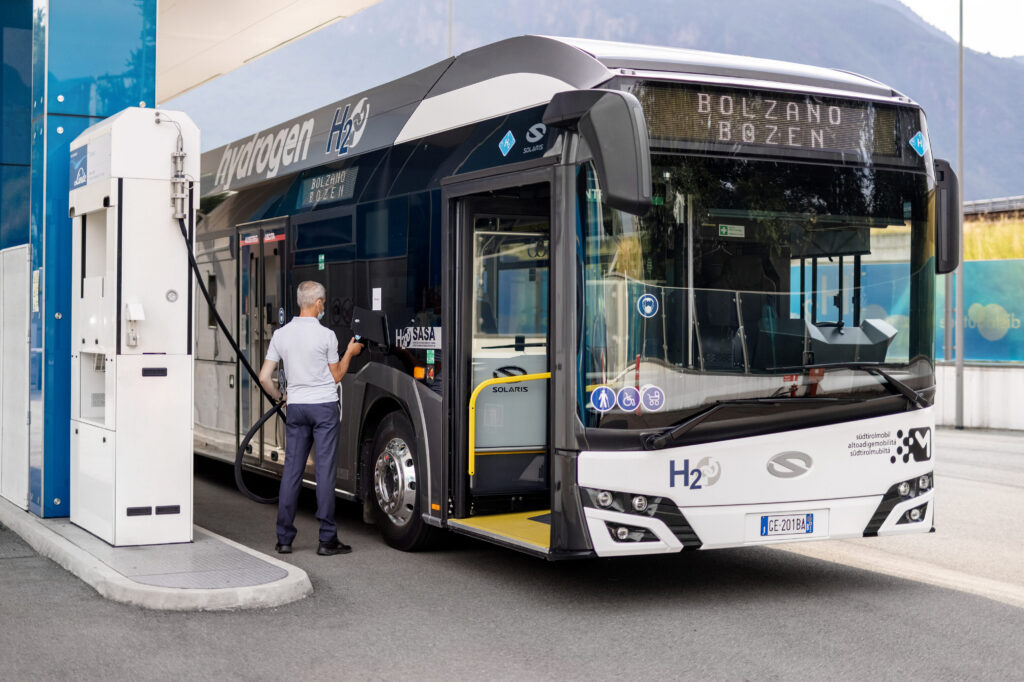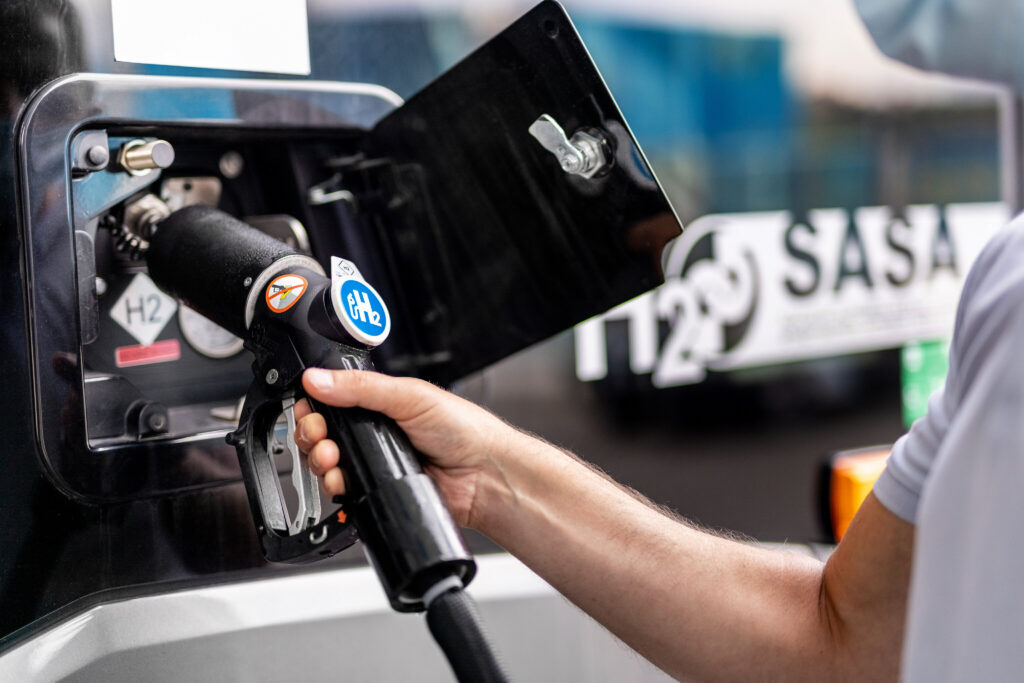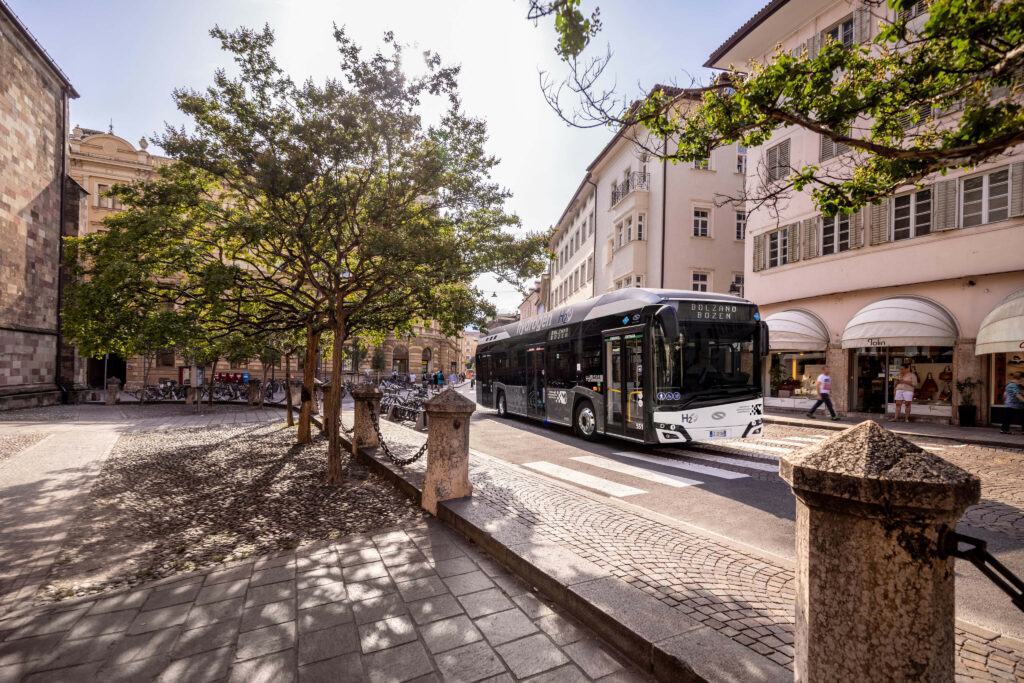
How does a hydrogen bus work?
Normally, when we talk about electric vehicles, we mean those with batteries. However, buses and cars powered by hydrogen cells are also electric. Hydrogen is currently enjoying great popularity and is referred to by many as the fuel of the future. So how does a hydrogen bus work?
The advantages of hydrogen
The advantages of hydrogen as an energy source are indisputable. Thanks to its density and lightness, this element may constitute a clean energy source for vehicles. Vehicles equipped with hydrogen technology also offer a greater range than battery-driven vehicles – they can cover a distance of up to several hundred kilometres on a single charge. Hydrogen refilling takes little time and is quite convenient, not differing much in essence from refilling a vehicle with petrol.
Do you know how many hydrogen refueling stations are currently in Europe? Read here.

Hydrogen is a fuel that is also ideal for powering heavy-duty, large-scale vehicles – including buses, which are essential for urban transport. Hydrogen technology used to produce electricity enables buses to travel even greater distances with absolutely no emissions and low noise and vibration.
Fuel cell as miniature power plant
At the heart of the hydrogen bus is a cutting-edge fuel cell that acts as a miniature hydrogen power plant on board.
In the device electric power is generated as the vehicle is used in a process called reverse electrolysis. The sole products of the chemical reaction occurring in the fuel cell are heat and steam. Consequently, the vehicle does not generate any noxious substances whatsoever
Electricity is passed on directly to the driveline. Thanks to this technology, the bus can achieve a range of up to several hundred kilometres on a single refill.
A set of 60 kW fuel cells was used in the Solaris hydrogen buses. As a whole, the hydrogen system contains also auxiliary devices, responsible for instance for the supply of gas and oxygen at an adequate pressure, for the recirculation of the resource that has not been used up, and also for maintaining a proper and stable temperature of the fuel cells during operation.
How does a hydrogen bus work?
But what actually happens while driving and how does the energy flow in the bus? To begin with, hydrogen and oxygen must be supplied to the fuel cell. The Hydrogen comes from tanks on the roof, the oxygen – from the air. In the next step, electricity and water vapour are produced by a chemical reaction. The hydrogen reaches the catalyst and splits into protons and neutrons. The cell contains a proton exchange membrane PEM. Protons penetrate to the other side and electrons are captured and sent to an external circuit, producing an electric current to power the motors. The hydrogen protons that cross over to the catalyst on the cathode side then bind with oxygen to form pure water. On one side we have pure hydrogen and pure oxygen, on the other side – just a bit of water.

ENERGY FLOW IN HYDROGEN BUS
Step 1 Drawing in air (oxygen)
Step 2 Oxygen from the air and hydrogen from the tanks are delivered to the fuel cell
Step 3 Electric power and water are generated as a result of the chemical reaction
Upon reaching the catalyst, the hydrogen splits into protons and electrons. Only protons permeate the PEM membrane, crossing over to the cathode. Electrons created as a result of the hydrogen disintegration are then conducted to an external circuit in the form of an electric stream. The protons that went through the membrane, returning electrons, and the oxygen from the air combine, create water and heat.
Step 4 Electricity is fed into the driveline as well as to battery depending on demand
Step 5 The engine powers up, the vehicle is moving
Step 6 Water is removed from the vehicle.
Battery to support
The bus is fitted with a small Solaris High Power traction battery which is to support the fuel cell whenever the demand for energy is biggest. The battery is filled with energy derived from hydrogen and through the regenerative braking, though it is also possible to recharge it by means of a plug-in socket. Complementing the driveline is an axle with integrated electric motors.

Safety first
Hydrogen is compressed in gaseous form into 5 new-generation tanks placed alongside the bus roof. The hydrogen tanks themselves are rigorously tested, and are designed to ensure maximum safety for the driver, passengers and pedestrians. A multifunctional valve is installed at the end of each tank; this valve includes a range of safety elements: a solenoid valve, an emergency valve activated by high temperature and an overload valve cutting off the flow of hydrogen in case of loss of containment of the system. Today’s advanced hydrogen storage technology guarantees the highest level of safety.
Electromobility has more than one name
So which is better: electric buses or hydrogen buses? There is no answer to this question. In fact, they should not compete with each other. Both have their undeniable advantages, and both can respond to different challenges and transport needs of cities. One thing is certain: the simultaneous development of different e-mobility technologies – whether electric or hydrogen – will speed up the transformation of transport to clean, green and sustainable.

See also
How does a hydrogen cell work?
A hydrogen fuel cell is nothing more than a mini power plant on board a vehicle. Find out how does a hydrogen cell work!
„Strategic goal: sustainable transport”
Interview with Krzysztof Dostatni, CEO of MPK Poznań.


